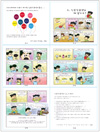Abstract
The purpose of this study was to develop a risk communication material on artificial food color additives for elementary school students. The development was based on a previous study on the perception and information needs of elementary school students on artificial food colors including that the students usually were interested in artificial food colors, but didn't know about those well, and they wanted to get information on the safety of their intake, function and necessity of food color additives. Based on the above results, a comic book on artificial food colors was developed as a risk communication material for the elementary school students by brainstorming and consultation with experts. The book was titled as 'Variegated artificial food colors! Understanding and Eating'. It contained basic information on food additives focused on artificial food colors including definition, function, calculation of ADI, usage of artificial food colors, quizzes and useful web sites, etc. The results of field evaluation for the developed material by 101 elementary school students were very positive in getting the correct information, understanding artificial food colors and having proper attitude for healthy dietary life. Therefore, the developed material could be used to help elementary school students have proper perception on artificial food colors and facilitate the risk communication on food additives.
Figures and Tables
 | Fig. 3Usefulness of the book by the elementary school students (*: 1 not useful at all, 2 not useful, 3 average, 4 useful, 5 very useful). |
Table 1
Composition of the questionnaire to evaluate the students' perceptions on artificial food colors

Table 2
The contents of the comic book developed 'Variegated artificial food colors! Understanding and Eating'

References
1. Baeck BS, Lee YH. Consumer's awareness and policies directions on food additives -focusing on consumer information. J Consum Stud. 2006. 17(3):133–150.
2. Burrows A. Palette of our palates: A brief history of food coloring and its regulation. Comp Rev Food Sci & Food Safety. 2009. 8:394–408.
3. Choi JS, Chun HK, Hwang DY, Nam HJ. Consumer perceptions of food-related hazards and correlates of degree of concerns about food. J Korean Soc Food Sci Nutr. 2005. 34(1):66–74.
4. Choi SH. Dietary intake of food additives by Korean population -Coal tar dye, combined diet intake. A Report KFDA Research Project. 2006. 129–134.
5. Choi SH. Dietary intake of food additives by Korean population -Synthetic food colors. A Report KFDA Research Project. 2010. 50–75.
6. Daily Economy. Did candy make our children be distracted? Children's 50 favoriate food items' survey. 2009. cited 2009 June 16. Available from http://news.mk.co.kr.
7. Hyon SM. Improvement of dietary practices of elementary students through nutrition labeling education. 2006. Seoul: National University of Education;1–4. MS thesis.
8. Jang ES. The investigation of elementary school studentsexposure to food additives through the published data and the development of education material. 2007. Kyung Hee University;7–8. MS thesis.
9. KFDA. Knowing tar-based food colors correctly. 2006. Korea Food and Drug Administration;1–23.
10. Kim HC, Kim MR. Consumer attitudes towards food additives. J East Asian Soc Diet Life. 2005. 15(1):126–135.
11. Kim HH, Kim JW. Development of risk communication materials on artificial sweeteners based on the perception of elementary students on food additives. J Korean Pract Arts Educ. 2009. 22(3):145–160.
12. Kim HS. Study on the risk communication of the food. Univ Suwon Thesis Collection. 2004. 22:581–590.
13. Kim HY, Nam HS, Jung YH, Lee JH, Ha SC. Tar colors in food distributed throughout the Gyeong-in region -Monitoring favorite food items of children near elementary schools. Korean J Food Sci Technol. 2008. 40(3):243–250.
14. Kim MR. Food safety. 2004. Seoul: Shinjeong;103–106. 130–137.
15. Kim SM, Kim JW. Development of risk communication strategy and educatioal hompage on food additives. Korean J Community Nutr. 2010. 15(2):240–252.
16. Ko MH, Kim JW. Seoul elementary school students' perception and information needs on artificial food colorants. Korean J Food Cookery Sci. 2011. 27(6):487–495.
17. Lee HJ. A study on necessity nutritional education and food additives used for convenience foods. 2008. University of Ulsan;32–36. MS thesis.
18. Lee YM, Na BJ, Lee YS, Kim SC, Lee DH, Seo IW, Choi SH, Ha SD. Monitoring of tar color content in childen's snack and its exposure assessment. J Food Hyg Saf. 2011. 26(1):57–63.
19. Min JE. A study on purchase behaviors of processed food and recognitions of food additives for elementary school students and their parents. 2009. Hanyang University;24–31. MS thesis.
20. Nachay K. A new color palette emerges. Food Technol. 2009. 63(4):50–62.
21. Nocutnews. Too bad, financial world, the reason to look away children's health right. 2009. cited 2009 July 13. Available from http://www.nocutnews.co.kr.
22. Park M, Park HR, Kim SJ, Kim MS, Kong KH, Kim HS, Gong EJ, Kim ME, Kim HS, Lee BM, Lee J. Risk assessment for the combinational effects of food color additives: Neural progenitor cells and hippocampal neurogenesis. J Toxicol Environ Health A. 2009. 72:1412–1423.
23. Yang SH, Kim JW. Development of risk communication materials on sulfur dioxide-nitrite based on the perception and needs of elementary students on food additives. J Korean Pract Arts Educ. 2010. 23(1):51–71.




 PDF
PDF ePub
ePub Citation
Citation Print
Print











 XML Download
XML Download